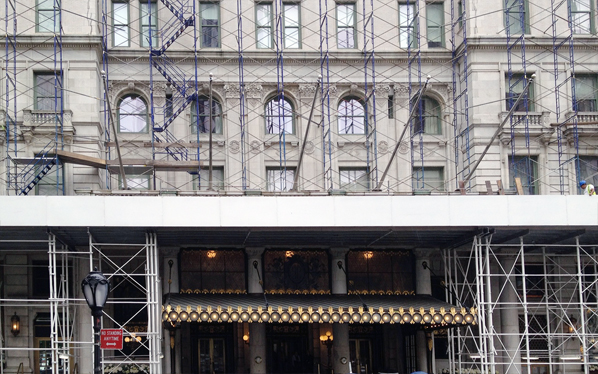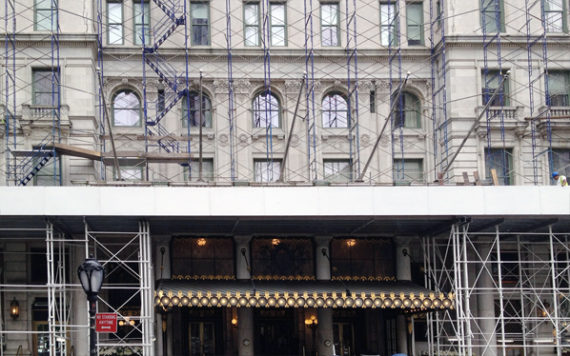
Restoration of a Building: 6 Areas That Matter Most
13 minutes read
Brendan Garvin
Jan 9, 2025 10:15:00 AM


Over time, even the most beautiful, well-constructed buildings require restoration.
Restoration of a building not only breathes new life into its appearance but also improves its safety and durability. This process allows owners to preserve memories associated with the space, rather than erasing the original “feel” through major renovations or demolitions.
For subcontractors, older buildings often hold unexpected challenges.
However, by identifying specific signs of damage and focusing on high-priority areas, commercial restoration can bring efficiency and success to any project.
6 Tips for Prioritizing the Restoration of a Building
If a project surpasses renovation-level and needs a full-on restoration, area building codes will already dictate construction means and methods to an extent. Nonetheless, there are six priorities that demand your attention, no matter the building type or location:
- Safety first: Securing the foundation
- Keeping the charm intact
- Concrete solutions for sturdy repairs
- Modern touches with care
- Greener pastures in building restoration
- Zeroing in on high-value areas
1. Safety First: Securing the Foundation
Are the building's high-traffic and structurally influential elements still as protected as they were on Day 1?
Sometimes restoration is necessary to guarantee safety. In a parking garage, for example, damage over time from weather and heavy use calls for extensive repair before it becomes a failure risk. Restoring a parking garage might involve sealing and waterproofing joints so the structure withstands rain, or using mortar to patch up cracks and other damage. If there are concerns around the structural safety of a building, it’s better to begin restoration sooner than later.
Have you waterproofed your plaza deck? Applied a corrosion inhibitor? Plaza decks and similar heavy-use areas are prime candidates for rehabilitation. By using the right protection products and application, you'll not only help the restoration last longer, you'll also make the building safer for users.
Note that historic buildings come with their own codes and regulations. If you're not already an expert with lots of historic building restoration training, consult with someone who is. It'll save time, money, and frustration for property owner and contractor alike.
2. Keeping the Charm Intact
An owner's property — and your work — act as a storefront, even if it's not in the literal sense. Having your named attached to a shoddy public-facing space is like running a smear campaign against yourself.
Many architects and contractors want to put their modern touch on an old building. It's best to respect the character of a historic building as much as possible when adding or changing features. The new version should account for the original architect's intent, as well as any public sentiment about the building. This philosophy involves meticulously avoiding damage to character-defining features and finishes.
Repair is preferable to replacement, but sometimes the latter is unavoidable. When sourcing replacement material, match the original color, design, and perhaps even texture as much as possible.

3. Concrete Solutions for Sturdy Repairs
Restoration comes in many forms, but brick, concrete, and stone are the most commonly candidates for an overhaul.
Restoration of concrete structures plays an integral part in cities and towns across America. It’s so omnipresent that it’s easy to forget what a crucial role it plays in our lives. This level of importance makes maintenance even more critical.
Whether it’s from chemicals, impact, water, seismic activity, or any other threat, repairing and protecting concrete is a critical part of many restoration jobs. The effort might range from simple cosmetic fixes to extensive replacements of parts or the entire structure.
Concrete repair techniques fall into three main categories:
- Injecting repairs — putting material into cracks, voids, or honeycombed areas for structural integrity and strength
- Surface treatments — applied to the concrete's exterior to address minor defects or add protection
- Material replacement — removing and replacing areas that are irreparable
The repair technique for a concrete structure depends on damage severity, function of the structure, and how the repair materials will behave over time. Luckily, a variety of materials are available today to fix up concrete with the techniques above.
4. Modern Touches With Care
Historic buildings and storefronts often rely on their curb appeal to get people in the door. To keep them inside, you'll need to bring the place up to modern standards of living.
Restoration should bring a building back to its original appearance and function — or even better.
What wouldn't faze the public decades ago might be inconvenient today. An obvious and extreme example is an accessibility feature for people with disabilities.
In situations where you want additional amenities, first assess whether the building can accommodate these new features without compromising structural integrity.
Many historic buildings have unique structural systems that demand careful consideration during any alteration or repair work. These systems might be delicate due to their age or design, requiring a sensitive approach to any modifications. In certain cases, integrating a completely new structural system might be necessary.
5. Greener Pastures in Building Restoration
Speaking of modern, does the building adhere to today's expectations for energy efficiency and general eco-friendliness?
There's a lot to gain with restoration, as it's possibly the most sustainable process in construction. It saves the consumption of material that'd otherwise go into new construction, and relative simple fixes can boost energy efficiency.
Examples of sustainable-minded updates include:
- Recycling & reusing — Reclaimed building parts are often more sustainable, cheaper, and higher-quality. Using recycled panels, bricks, and tiles can eliminate up to 95% of materials-related carbon emissions.
- Facades & insulation — Timber & stone are more energy-efficient than glass facades, at 50% of the maintenance cost. Natural fiber and recycled insulation don't introduce hazardous chemicals to installation. Externally applied moisture buffers are available in several effective varieties, including cotton and hemp.
- Coating — Water-based paint's carbon footprint is ⅓ lower than that of solvent-based paint. In addition to its lack of volatile chemicals, eco-friendly paint is great for breathability and better fiber protection.
6. Zeroing in on High-Value Areas
Sometimes a specific part of the building is functionally important. If it's aging, that's your cue to take action.
Restoration doesn’t always affect the entire building. Instead of renovating everything, restoration can focus on a more concentrated area.
In cases like wastewater treatment facilities, even a small area that needs restoration makes a big difference. Issues including damage and the general effects of aging have the potential to cause major problems within municipalities.
Restoring even a small area of a facility can prevent expensive and long-lasting damage.
Restoration Construction FAQsHere are some frequently asked questions about the restoration of a building. Q: Any common mistakes to avoid during building restoration?A: Common mistakes in building restoration often stem from poor initial assessments or a lack of clear planning. Skipping a thorough inspection can lead to underestimating the scope of necessary repairs, while neglecting to match replacement materials to the original design may harm the building’s historical integrity. Another frequent error is using inappropriate modern materials or techniques that may compromise the structure’s longevity or aesthetic appeal. Q: How can restoration efforts impact the surrounding environment or neighboring structures?A: Restoration projects can sometimes create disruptions in the surrounding area. Increased noise, dust, and vibrations from heavy machinery can disturb nearby residents or businesses. Q: What are the risks of not addressing specific problem areas promptly?A: Delaying restoration in areas showing damage can lead to more severe structural problems over time. |
Blending New Techniques With the Old in Building Restoration
Restoring a building for its aesthetic charm or historic significance is valuable for both the property owner and the contractors. You'll just need a plan for it to go smoothly.
Even if an old building is structurally sound, it can always be more eco- or user-friendly. On the process side, focus on bringing the building up to modern standards while retaining what made it stand out to begin with. On the toolkit side, lean on commercial-grade construction products specialized for restoration of masonry and facades, plaza decks, parking garages, or whatever you're updating.
More Restoration Insights Await
Restore, preserve, and modernize with confidence. Download our guide for expert tips on tackling restoration projects.
This article was originally published in May of 2023 and was recently updated to reflect current industry trends.

